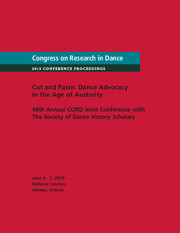Article contents
Between Boundaries of Tradition and Global Flows: Reimagining Communities in Kathak Dance
Published online by Cambridge University Press: 02 August 2016
Abstract
The aim of the paper is to examine the ongoing transformation in Kathak art and practice, in response to demands of global markets, sensibilities of new audiences, and the artists' personal need for self-expression. The paper explores why classical Indian dancers push the barriers of Kathak tradition, and how they redefine the idea of authenticity. Do the innovative choreographies indicate an increasing shift toward individualization, transnationalism, and cultural pluralism, or rather do they attempt to renegotiate the notions of “Indianness”? To what extent is genre hybridity considered as an emerging aesthetic value that reflects complex, multi-layered identities of the performers?
- Type
- Research Article
- Information
- Copyright
- Copyright © Katarzyna Skiba 2016
References
Works Cited
- 1
- Cited by


